The high-waisted gown of the late medieval period evolved in several directions in different parts of Europe. In the German states and Bohemia, gowns remained short-waisted, tight-laced but without corsets. The open-fronted gown laced over the kirtle or a stomacher or plackard. Sleeves were puffed and slashed, or elaborately cuffed.
In France, England, and Flanders, the high waistline gradually descended to the natural waist in front (following Spanish fashion) and then to a V-shaped point. Cuffs grew larger and were elaborately trimmed.
Hoop skirts or farthingales had appeared in Spain at the very end of the 15th century, and spread to England and France over the next few decades. Corsets also appeared during this period.
A variety of hats, caps, hoods, hair nets, and other headresses were worn, with strong regional variations.
Shoes were flat, with broad square toes.
German fashion
In the first half of the 16th century, German dress varied widely from the costume worn in other parts of Europe. Skirts were cut separately from bodices, though often sewn together, and the open-fronted gown laced over a kirtle with a wide band of rich fabric, often jeweled and embroidered, across the bust. Partlets (called in German gollers or collars) were worn with the low-cut bodice to cover the neck and shoulders, and were made in a variety of styles. The most popular goller was a round shoulder-capelet, frequently of black velvet lined in silk or fur, with a standing neckband; this goller would remain in use in some parts of Germany into the 17th century and became part of national dress in some areas.
Narrow sleeves were worn in the earliest years of the century, and were later decorated with bands of contrasting fabric and rows of small panes or strips over puffed linings. Skirts were trimmed with bands of contrasting fabric, but were closed all around. They would be worn draped up to display an underskirt.
From 1530, elements of Spanish dress were rapidly adopted in fashionable Germany under the influence of the imperial court of Charles V.
Gowns
Dress in Holland, Belgium, and Flanders, now part of the Empire, retained a high, belted waistline longest. Italian gowns were fitted to the waist, with full skirts below.
The French gown of the first part of the century was loosely fitted to the body and flared from the hips, with a train. The neckline was square and might reveal the kirtle and chemise beneath. Cuffed sleeves were wide at the wrist and grew wider, displaying a decorated undersleeve attached to the kirtle. The gown fastened in front early, sometimes lacing over the kirtle or a stomacher, and the skirt might be slit in front or the train tucked up in back to display the skirt of the kirtle.
As a fitted style emerged under Spanish influence, the gown was made as a separate bodice and skirt; this bodice usually fastened at the side or the side-back with hooks and eyes or lacing.
Hats and headgear
In France, England, and the Low Countries, black hoods with veils at the back were worn over linen undercaps that allowed the front hair (parted in the middle) to show. These hoods became more complex and structured over time.
Unique to England was the gable hood, a wired headdress shaped like the gable of a house. In the 16th century gable headdress had long embroidered lappets framing the face and a loose veil behind; later the gable hood would be worn over several layers that completely concealed the hair, and the lappets and veil would be pinned up in a variety of ways.
A simple rounded hood of the early years of the century evolved into the French hood, popular in both France and England; its arched shape sat further back on the head and displayed the front hair which was parted in the center and pinned up in braids or twists under the veil.
Linen caps called coifs were worn under the fur cap, hood or hat.
In warmer climates including Italy and Spain, hair was more often worn uncovered, braided or twisted with ribbons and pinned up, or confined in a net. A Spanish style of the later 15th century was still worn in this period: the hair was puffed over the ears before being drawn back at chin level into a braid or wrapped twist at the nape.
First-time brides wore their hair loose, in token of virginity, and a wreath or chaplet of orange blossoms was traditional. A jeweled wreath with enameled "orange blossoms" was sometimes worn.
Jewelry and accessories
Women of wealth wore gold chains and other precious jewelry; collar-like necklaces called carcanets, earrings, bracelets, rings, and jeweled pins. Bands of jeweler's work were worn as trim by the nobility, and would be moved from dress to dress and reused. Large brooches were worn to pin overpartlets to the dress beneath.
Dress hooks, of silver gilt for the wealthy and of base metal for the lower classes, were worn to loop up skirts.
A fashionable accessory was the zibellino, the pelt of a sable or marten worn draped at the neck or hanging at the waist; some costume historians call these "flea furs". The most expensive zibellini had faces and paws of goldsmith's work with jewelled eyes.
However, it should be noted that not all women or men were allowed to wear jewelry because of the sumptuary laws that restricted wearing certain types of jewelry and luxurious fabrics, such as purple velvet, to first royalty and then nobility. The newly wealthy merchant classes who were not aristocrats could not wear jewelry on their clothing or fabrics restricted to nobles.
Gloves of soft leather had short, sometimes slashed, cuffs and were perfumed.
Beauty Ideals
Portraits produced during the Renaissance provide an invaluable resource for visualizing and understanding the beauty ideals of the period. Sandro Botticelli’s Venus and Mars, painted between 1480-1490 depicts Venus as the ultimate amalgamation of female physical beauty. Her face is perfectly symmetrical, her skin is unblemished and pure white, her hair is light in color and slightly waved, her forehead is high, her eyebrows are severely arched, her lips are red and full and her abdomen and hips protrude slightly under her thin garment.
Women often applied toxic substances to their faces and chests such as mercury, alum, and ceruse to lighten the skin and remove freckles. However, these products, such as ceruse, a lead derivative severely irritated the skin, leaving women’s faces blemished and burned. Although safer alternatives existed, women preferred the consistency and coverage offered by ceruse. Not all cosmetics were dangerous, many women relied on lotions and balms containing almonds, olive oil, lemon juice, bread crumbs, eggs, honey, rosewater and snake fat to clarify and cleanse the skin. Red lips and rosy cheeks were achieved primarily through the application of vermilion; ceruse mixed with organic dyes such as henna and cochineal (a powder made from the ground exoskeleton of insects). In Italy especially, women sought to achieve the light tresses that were viewed as the ideal. Women applied mixtures of lemon juice, alum and white wine and sat in the sun to lighten their hair. In order to produce loose curls, women wrapped hair saturated in gum arabic or beer around clay curlers. Finally, the appearance of a high forehead was achieved by plucking hairs along the hairline, and severely arching or removing the eyebrows altogether. Although at this time, women could not cosmetologically alter the symmetry of their face, or the structure of their nose in order to obtain the ideal, the products available allowed them to come close.
Style gallery – German States and the Low Countries 1500s–1520s

1 – 1502–03
| 
2 – c 1506
| 
3 – 1514
| 
4 – 1525–30
|
|---|---|---|---|

5 – 1526
| 
6 – 1526 Bride
| 
7 – 1526–30
| 
8 – 1529
|
1.Anna Cuspinian wears a rose-pink brocade gown with a high belt and black collar and cuffs with a large headdress 1502–03.
2.St Dorothea wears a black goller or round partlet over a gown with an organ-pleated skirt and a snug bodice trimmed with embroidery. She wears pieced sleeves derived from Italian styles with puffs at the elbows and shoulders, a heavy gold chain, and a gold filigree carcanet or necklace, 1506.
3.Duchess Katharina von Mecklenburg wears a front-laced gown in the German fashion, with broad bands of contrasting materials, tight sleeves, and slashes at the elbow, 1514.
4.Three ladies in German fashion of 1525–30. Baretts with upturned slashed brims are worn over cauls, and sleeves are variously puffed, pieced, and slashed, with short wide cuffs extending over the hands.
5.Katharina von Bora wears a front-laced grayish gown with black trim. She wears a white partlet edged in black, and her hair is confined in a net or snood, 1526.
6.Princess Sibylle von Cleves as a bride wears a tight-waisted gown with slashed and puffed sleeves over a high-necked chemise with a wide band at the neck. Her loose hair and the jeweled wreath of orange blossoms indicate that this is a bridal painting, 1526.
7.Widows in the Netherlands wear <i>barbes' or wimples with linen headdresses, 1526–30.
8.Woman spinning of 1529 wears the linen cap and hood and black partlet characteristic of middle-class costume in the Netherlands in the 1520s.</i>
Style gallery – Italy and Spain 1500s–1520s

1 – 1505
| 
2 – 1505
| 
3 – 1505
| 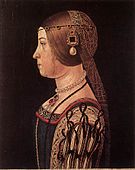
4 – 1510
|
|---|---|---|---|

5 – 1516
| 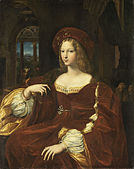
6 – 1518
| 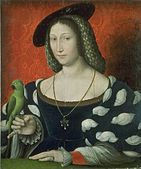
7 – 1527
|
2.Spanish fashion: A velvet gown with slashed sleeves is worn over a chemise embroidered in black silk at the neckline (visible beneath the net partlet) and in bands down the wide sleeves, Toldeo, c. 1505.
3.Venetian woman wears a patterned gown with tied-on sleeves that show the chemise beneath. Her hair frames her face in soft waves, and back hair is confined in a small draped cap, c. 1505.
4.Barbara Palavicino wears slashed sleeves tied in bows at the shoulders. Her long hair is confined in a small embroidered cap and then wrapped in a long tail down her back. She wears a fillet or ferroniere around her forehead.
5.Italian gown of floral silk has wide, puffed upper sleeves and fitted lower sleeves. Her chemise is high-necked and small frills are visible at the wrists. She wears a heavy gold chain.
6.Joanna of Aragon wears a gown with wide, open sleeves lined in light pink. Her high waist is accentuated with a knotted sash. The full sleeves of her chemise are gathered into ornamented bands, and she wears a broad hat that matches her gown, 1518.
7.Marguerite d'Angoulême wears the Italian style common in Savoy. Her black gown has very large puffed upper sleeves with a white lining pulled through numerous cuts or slashes. Her hair is confined in a bag-like fabric snood under a broad black hat, c. 1527.
Style gallery – England and France 1500s–1520s

1 – 1500
| 
2 – 1500
| 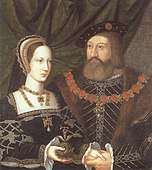
3 – 1516
| 
4-1525
|
|---|---|---|---|

5 – 1527
| 
6 – 1527–28
| 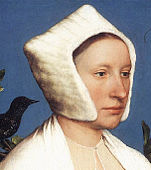
7 – 1527–28
| 
8 – 1528–30
|
1.Elizabeth of York wears an early gable hood and a front-closing red gown with a fur lining or trim and fur cuffs, c. 1500.
2.An unidentified princess believed to be Mary Tudor or Catherine of Aragon wears a round hood over a linen cap and a dark gown over a kirtle. Her square-necked smock has a narrow row of embroidery at the neck, and she wears a jeweled collar or carcanet and a long, heavy gold chain, early C 16.
3.Henry VIII's sister Mary Tudor's marriage portrait (with Charles Brandon) in a French gown shows the cuffs of her sleeves turned back to display a lining decorated with pearls. She wears a French hood. Her undersleeves have an open seam caught with jeweled clasps or pins and her chemise sleeves are pulled through the openings in small puffs, 1516.
4.Catherine of Aragon, c.1525, wears a gable hood with the lappets folded up and pinned in place, and the veil hanging loosely in back. Her gown has a pattern of jewels at the neckline, and her wide sleeves are turned up to show the lining.
5.Mary Wotton, Lady Guildenford wears a gable hood with a loose veil. The bodice of her gown (presumably laced at the side-back or back) is decorated with draped chains, and her smock sleeves are pulled through the open outer seam of her undersleeves in neat puffs, 1527.
6.Two ladies of Thomas More's family wear dark gowns laced over colored kirtles with contrasting undersleeves. 1527–28.
7.Holbein's Anne Lovell wears a fur cap shaped like a gable hood. She wears a linen kerchief or capelet draped over her shoulders, and a sheer parlet, 1527–28.
8.Drawing by Holbein shows front and back views of English dresses and gable hood of 1528–30.
Source From Wikipedia
没有评论:
发表评论